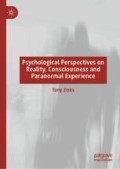Abstract
In terms of seeing paranormal things like ghosts, locked within the expanded realm is the potentiality of unrealised states which includes both the here-and-now awareness of mental, physical and perceptual elements, and the vast plain of unrecognised material..
Access this chapter
Tax calculation will be finalised at checkout
Purchases are for personal use only
Notes
- 1.
Brabant (2016).
- 2.
A term for an expanded or extended consciousness.
- 3.
- 4.
Weitz (1976): Very roughly, there might be some reference to archetypes as patterned in a morphic field, but that might upset stringent depth psychologists.
- 5.
Kaminker (2016).
- 6.
Stevens (1998).
- 7.
van der Sluijs and Peratt (2009); also represented as a rounded object, four pillars, axis mundi, a rainbow, and lightning.
- 8.
Ibid., p. 21.
- 9.
- 10.
Martin‐Vallas (2013).
- 11.
Ibid.
- 12.
Joseph (2001); Of course, people share everything else in the brain, but that’s not the point!
- 13.
Kaminker (2016, p. 93).
- 14.
Zhu (2013).
- 15.
Welman and Faber (1992, p. 65).
- 16.
Urban (2005).
- 17.
Bradshaw and Storm (2013).
- 18.
Lash and Polyson (1987).
- 19.
- 20.
Rosen et al. (1991).
- 21.
Fordham (1953).
- 22.
Lash and Polyson (1987).
- 23.
Jung’s proposition about the paranormal, made in his 1959 writings.
- 24.
van Erkelens (1991).
- 25.
Clarke and Coleman (1975, p. 238).
- 26.
Jinks (2012, p. 19).
- 27.
Kottmeyer (2006).
- 28.
Williams (2005).
- 29.
Kottmeyer (2006).
- 30.
Bolea (2015, p. 281).
- 31.
Williams (2005).
- 32.
Ibid., p. 134.
References
Bolea, S. (2015). The Shadow Archetype of the Vampire in Three Horror Movies. Caietele Echinox, 28, 281–289.
Brabant, O. (2016). More Than Meets the Eye: Towards a Post-materialist Model of Consciousness. Explore, 12(5), 347–354.
Bradshaw, S., & Storm, L. (2013). Archetypes, Symbols and the Apprehension of Meaning. International Journal of Jungian Studies, 5(2), 154–176.
Clarke, J., & Coleman, L. (1975). The Unidentified: Notes Towards Solving the UFO Mystery. New York: Warner Paperback Library.
Fordham, F. (1953/1959). An Introduction to Jung’s Psychology. Harmondsworth: Penguin Books.
Huston, H. (1999). The Evolutionary Significance of Archetypal Dreams. In D. H. Rosen & M. C. Luebbert (Eds.), Evolution of the Psyche (pp. 188–195). Westport, CT: Greenwood Publishing Group.
Jinks, A. (2012). An Introduction to the Psychology of Paranormal Belief and Experience. Jefferson, NC: McFarland.
Joseph, R. (2001). The Limbic System and the Soul: Evolution and the Neuroanatomy of Religious Experience. Zygon, 36(1), 105–136.
Jung, C. G. (1990). The Archetypes and the Collective Unconscious (10th ed.; R. F. C. Hull, Trans.). Princeton: Princeton University Press (Original work published 1959).
Jung, C. G. (1991). Flying Saucers: A Modern Myth of Things Seen in the Skies (R. F. C. Hull, Trans.). Princeton: Princeton University Press (Original work published 1959).
Kaminker, J. (2016). Images, Figures and Qualities: Clarifying the Relationship Between Individual and Archetype. International Journal of Transpersonal Studies, 35(2), 93–102.
Kottmeyer, M. (2006, February 25). Letters to Ye Olde Editor. Saucer Smear, 53(2).
Lash, S. J., & Polyson, J. A. (1987). The Gender Relevance of Projected Animal Content. Journal of Clinical Psychology, 43(1), 145–150.
Martin‐Vallas, F. (2013). Are Archetypes Transmitted or Emergent? A Response to Christian Roesler. Journal of Analytical Psychology, 58(2), 278–285.
Nunn, C. M. H. (1998). Archetypes and Memes: Their Structure, Relationships and Behaviour. Journal of Consciousness Studies, 5(3), 344–354.
Rosen, D. H., Smith, S. M., & Huston, H. L. (1991). Empirical Study of Associations Between Symbols and Their Meanings: Evidence of Collective Unconscious (Archetypal) Memory. Journal of Analytical Psychology, 36(2), 211–228.
Stevens, A. (1998). Response to P. Pietikainen. Journal of Analytical Psychology, 43, 345–355.
Urban, E. (2005). Fordham, Jung and the Self: A Re-examination of Fordham’s Contribution to Jung’s Conceptualization of the Self. Journal of Analytical Psychology, 50(5), 571–594.
van der Sluijs, M. A., & Peratt, A. L. (2009). The Ourobóros as an Auroral Phenomenon. Journal of Folklore Research, 46(1), 3–41.
van Erkelens, H. (1991). Wolfgang Pauli’s Dialogue with the Spirit of Matter. Psychological Perspectives: a Semi-Annual Journal of Jungian Thought, 24(1), 34–53.
Weitz, L. J. (1976). Jung’s and Freud’s Contributions to Dream Interpretation: A Comparison. American Journal of Psychotherapy, 30(2), 289–293.
Welman, M., & Faber, P. A. (1992). The Dream in Terminal Illness: A Jungian Formulation. Journal of Analytical Psychology, 37(1), 61–81.
Williams, R. J. (2005). The Symbol of the Hybrid Human/Alien Child in the Abduction Phenomenon: Rebirthing Within the Psyche and the Psychosomatic Imagination. Proceedings of the Eighth Australian and International Religion, Literature and the Arts Conference 2004. http://hdl.handle.net/2123/1263.
Zhu, C. (2013). Jung on the Nature and Interpretation of Dreams: A Developmental Delineation with Cognitive Neuroscientific Responses. Behavioral Sciences, 3(4), 662–675.
Author information
Authors and Affiliations
Corresponding author
Rights and permissions
Copyright information
© 2019 The Author(s)
About this chapter
Cite this chapter
Jinks, T. (2019). Witnessed Experience and the Third-Path. In: Psychological Perspectives on Reality, Consciousness and Paranormal Experience. Palgrave Macmillan, Cham. https://doi.org/10.1007/978-3-030-28902-7_33
Download citation
DOI: https://doi.org/10.1007/978-3-030-28902-7_33
Published:
Publisher Name: Palgrave Macmillan, Cham
Print ISBN: 978-3-030-28901-0
Online ISBN: 978-3-030-28902-7
eBook Packages: Behavioral Science and PsychologyBehavioral Science and Psychology (R0)

